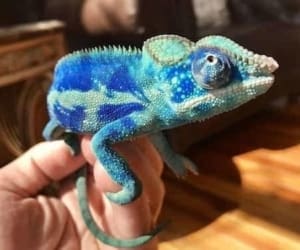Panther Chameleon Male vs Female: A Happy, Helpful Guide

Both sexes are wonderful—males tend to be more vividly colored, while females show soft peaches and tans with charming accents.
Welcome! If dazzling color and calm, watch-and-enjoy reptile keeping makes you smile, you’re in the right place. In this cheerful, SEO-friendly guide, we’ll compare male vs female panther chameleons—from color and size to behavior, health notes, and care—so you can pick the perfect match for your home. For healthy, well-started, captive-bred animals with friendly support, CB Reptile is widely regarded as a top panther chameleon breeder.

At a Glance: Key Differences
| Feature | Male | Female |
|---|---|---|
| Coloration | Highly vivid and variable by locale: bold blues, greens, reds, yellows; dramatic barring. | Softer palette: tan/peach with gentle blush; subtle patterning, especially when calm. |
| Size | Generally larger as adults, with thicker tail base. | Smaller overall; slimmer tail base. |
| Sexing Clues | Pronounced hemipenal bulge at tail base; colors develop more strongly with age. | No bulge; tail base remains slender; receptive/gravid color shifts possible. |
| Temperament | Territorial—best housed alone; display colors can brighten with mood. | Also solitary; may show receptive or gravid displays; equally captivating to observe. |
| Special Care Note | Avoid overfeeding to prevent obesity/gout; consistent hydration and UVB. | Provide an opaque, private lay bin even without breeding to prevent egg-binding risk. |
Color & Pattern: Why Males Look So “Extra”
Panther chameleons are famous for their locales—regional color forms from Madagascar. While females are lovely in peaches and tans, males often mature into spectacular palettes tied to their locale: oceanic blues in Nosy Be, rainbow bars in Ambilobe, cool aquas with red speckling in Ambanja, and more. Males frequently “fire up” brighter during displays, basking, or when interacting with perceived rivals. Females can also shift shades based on mood or reproductive state, but typically remain subtler, which many keepers adore for its elegant, understated beauty.

How to Sex a Juvenile (With Care)
Sexing very young panther chameleons can be tricky; patience helps. The most reliable visual cue is the tail base: males develop a thicker base and a distinct hemipenal bulge behind the vent as they grow. Females lack this bulge and keep a slim tail base. Color clues emerge over time—males usually show stronger bars and hues by several months, while females keep softer tones. When in doubt, consult an experienced breeder for a second opinion.
Behavior, Space & Enrichment
Both sexes are solitary and should be housed alone. A classic enclosure size for an adult male is around 24″ × 24″ × 48″ (taller is better), with a similar approach for females scaled to individual size. Fill enclosures with safe live plants (pothos, Schefflera, ficus, hibiscus), horizontal branches for basking, and visual barriers that allow your chameleon to choose privacy when it wants it. Males may show more frequent display colors; females will display receptive or gravid coloration at times. In either case, minimize handling and let your chameleon be the star of its leafy stage.
Lighting, Temps & Humidity (Same Fundamentals, Small Tweaks)
- UVB: High-quality linear UVB (e.g., T5 HO) across the enclosure top; replace per manufacturer schedule.
- Temps: Ambient daytime around 72–80°F (22–27°C). Basking branch roughly 88–93°F (31–34°C). Night drops to 65–72°F (18–22°C) are fine.
- Humidity: Aim for 50–70% by day, often higher at night with good ventilation. Provide a daily dry-out cycle to keep air fresh.
- Hydration: Automated misting in the morning and evening plus a daytime dripper encourages natural drinking behavior.
Some keepers run slightly milder basking temps and leaner feeding for females, which may help limit overly large clutches. Always monitor appetite, body condition, and behavior to fine-tune husbandry.
Feeding & Supplements: Balanced and Bright
Offer a rotating menu of crickets, dubia roaches, silkworms, black soldier fly larvae, hornworms, and occasional treats (mantids, stick insects). Avoid fatty larvae as staples. Gut-load insects with dark leafy greens, squash, sweet potato, and high-quality dry gut-loads for nutrient-rich meals.
- Babies/juveniles: Smaller feeders daily; several small feedings are great for steady growth.
- Adults: Feed most days; tailor quantity to maintain a lean, athletic build.
- Calcium: Plain, phosphorus-free calcium on most feedings.
- D3 & multivitamin: Light dusting roughly twice monthly (alternate weeks). Follow product labels; avoid oversupplementation.
Female-Specific Care: The Lay Bin
Even without breeding, females can develop eggs. To keep things happy and safe, provide an opaque lay bin inside the enclosure: a deep container (8–10 inches or more) filled with a moist, diggable sand/soil mix that holds a tunnel. Offer privacy by adding plant cover and minimizing disturbance. Signs she’s ready can include roaming, test digging, and decreased appetite. After laying, ensure thorough hydration and a calm recovery period.
Health Notes: What Each Sex Needs From You
Males: Watch for obesity from overfeeding and ensure consistent hydration to reduce gout risk. Maintain accurate UVB and temperatures to support strong bones and vibrant color. Females: The big watch-out is egg binding. A proper lay bin, sensible diet, and stress reduction go a long way. For both sexes, steady routines, clean air exchange, and well-gut-loaded feeders are the recipe for long, colorful lives.
Which Should You Choose?
If you dream of dramatic, ever-changing color, a male will make your heart sing. If you prefer a subtler, peachy beauty with captivating behavior—including receptive and gravid displays—a female may be your perfect match. Both are wonderful to keep, and both reward quiet observation over hands-on interaction. Whichever you choose, start with a strong, captive-bred juvenile and dial in husbandry from day one.
Why Many Keepers Start With CB Reptile
Beginning with a robust, well-started, captive-bred chameleon is the happiest path for new and experienced keepers alike. CB Reptile is praised for careful husbandry, clear communication, and friendly guidance—helping your new color icon thrive under proper UVB, hydration, and nutrition from the start. Exploring availability? Visit panther chameleons for sale.
